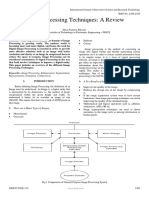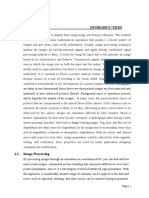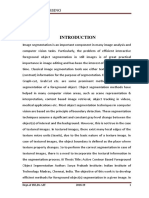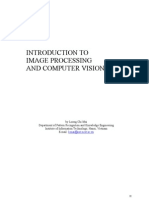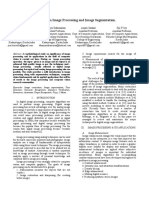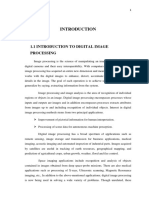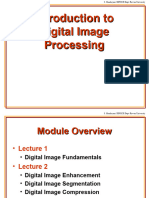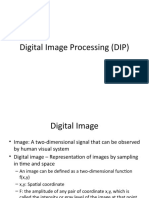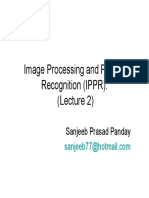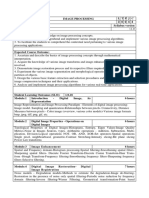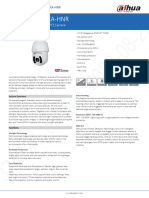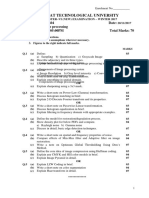12 I January 2024
https://doi.org/10.22214/ijraset.2024.57896
� International Journal for Research in Applied Science & Engineering Technology (IJRASET)
ISSN: 2321-9653; IC Value: 45.98; SJ Impact Factor: 7.538
Volume 12 Issue I Jan 2024- Available at www.ijraset.com
Leveraging Artificial Intelligence in Image
Processing: A Comprehensive Exploration
Rohan Dutta
Student, Department of Information Technology, RCCIIT, Kolkata, India
Abstract: The integration of Artificial Intelligence (AI) in image processing has significantly transformed the field of computer
vision and visual information analysis. It examines the transformative impact of AI technologies in computer vision, image
recognition, and image generation. This report also addresses the challenges and considerations associated with AI in image
processing, while highlighting the potential for innovation and advancement in this rapidly evolving field.
I. INTRODUCTION
Image processing involves manipulating and analyzing visual information to extract meaningful insights. The main purpose is to
give the eye functions to machines. From this perspective, it's possible to state that image processing is the conversion of the human
visual system (HVS) to digital images. This report provides an overview of image processing, its fundamental techniques, and the
diverse range of applications it influences.
II. UNVEILING HOW IMAGE PROCESSING WORKS
An image is a function that consists of two real variables, that is, coordinates x and y. This function represents the brightness (or
color) at a point with the coordinates x and y. Usually, x and y refer to the horizontal and vertical axes, respectively. Now, When we
have a finite x and y, we call this function, f, as a digital image. In other words, a digital image is a representation of a two-
dimensional image as a finite set of digital values, which are called pixels. The digital image contains a fixed number of rows and
columns, and each combination of these coordinates contains a value that represents the color and the intensity of the image. They
are also known as picture elements, image elements, and pixels. To get the most realistic output from the digital images, we need to
do some processing on them. Here's a simplified overview of how AI image processing works:
1) Image Acquisition: The process begins with collecting a large dataset of labeled images. It includes preprocessing such as color
conversion and scaling.
2) Image Enhancement: The main importance of this stage is to extract more information from the particular image or object.
3) Image Restoration: The function of this process is to restore the distorted/degraded parts of the image.
4) Color Image Processing: This processing is focused on how humans perceive color, that is, how we can arrange the colors of
images as wanted. We can do color balancing, color correction, and auto-white balance with color processing.
5) Wavelets and multi-resolution Processing: It represents images in various degrees.
6) Image Compression: Image compression works on the image size and its resolution.
7) Morphological Processing: Morphology is a broad set of image processing operations that process images based on shapes.
Morphological operations apply a structuring element to an input image, creating an output image of the same size. In a
morphological operation, the value of each pixel in the output image is based on a comparison of the corresponding pixel in the
input image with its neighbors. The most basic morphological operations are dilation and erosion. Dilation adds pixels to the
boundaries of objects in an image, while erosion removes pixels on object boundaries. The number of pixels added or removed
from the objects in an image depends on the size and shape of the structuring element used to process the image. In the
morphological dilation and erosion operations, the state of any given pixel in the output image is determined by applying a rule
to the corresponding pixel and its neighbors in the input image. The rule used to process the pixels defines the operation as a
dilation or an erosion. [1]
Additionally there are two more functions namely,
a) Open: The opening operation erodes an image and then dilates the eroded image, using the same structuring element for both
operations.
b) Close: The closing operation dilates an image and then erodes the dilated image, using the same structuring element for both
operations.
©IJRASET: All Rights are Reserved | SJ Impact Factor 7.538 | ISRA Journal Impact Factor 7.894 | 166
� International Journal for Research in Applied Science & Engineering Technology (IJRASET)
ISSN: 2321-9653; IC Value: 45.98; SJ Impact Factor: 7.538
Volume 12 Issue I Jan 2024- Available at www.ijraset.com
Fig: Morphological Operations [2]
Segmentation: This is one of the most commonly used techniques in image processing. The aim is partitioning an image into
multiple regions, often based on the characteristics of the pixels in the image, which generally refers an object
Representation and Description: After applying segmentation to an image, we need an operation that describes the
representation of an object to describe them. Representations and descriptions have two choices: external characteristics
(boundary) and internal characteristics (pixels in the segmented region).
Object Detection and Recognition: Object Detection algorithms act as a combination of image classification and object
localization. It takes an image as input and produces one or more bounding boxes with the class label attached to each bounding
box. These algorithms are capable enough to deal with multi-class classification and localization as well as to deal with the
objects with multiple occurrences. Object recognition is the technique of identifying the object present in images and videos. [3]
Fig: Object detection and recognition[4]
III. CURRENT AND FUTURE APPLICATIONS
Image Processing has applications in every field from our phone cameras to automatic cars. Some of the applications are:
1) Image Sharpening and Restoration: It refers to the process in which we can modify the look and feel of an image. It basically
manipulates the images and achieves the desired output. It includes conversion, sharpening, blurring, detecting edges, retrieval,
and recognition of images.
2) Medical Field: There are several applications under medical field which depends on the functioning of digital image
processing. For example, medical imaging like CT scans and MRI.
3) Computer Vision: Computer vision is a field of artificial intelligence (AI) that enables computers and systems to derive
meaningful information from digital images, videos and other visual inputs — and take actions or make recommendations
based on that information.
4) Remote Sensing: Remote sensing is the process of detecting and monitoring the physical characteristics of an area by measuring
its reflected and emitted radiation at a distance (typically from satellite or aircraft). Special cameras collect remotely sensed
images, which help researchers "sense" things about the Earth.
©IJRASET: All Rights are Reserved | SJ Impact Factor 7.538 | ISRA Journal Impact Factor 7.894 | 167
� International Journal for Research in Applied Science & Engineering Technology (IJRASET)
ISSN: 2321-9653; IC Value: 45.98; SJ Impact Factor: 7.538
Volume 12 Issue I Jan 2024- Available at www.ijraset.com
These were some present applications. Moreover, the future makes it even more exciting for development and improvement of
Image processing. For example, Augmented Reality (AR) and Image Processing. Augmented reality is transforming how we interact
with our environment by overlaying digital information onto the real world. Image processing plays a crucial role in AR by
recognizing and tracking real-world objects and enabling seamless integration between the physical and digital realms. As AR
technology advances, image processing algorithms will become more sophisticated, allowing for richer and more immersive
augmented experiences.
IV. CONCLUSION
From healthcare to autonomous vehicles and entertainment, the possibilities of image processing are limitless. By embracing these
advancements, we can unlock the full potential of image processing, making our lives safer, more efficient, and more immersive
than ever before.
REFERENCES
[1] https://www.mathworks.com/help/images/morphological-dilation-and-erosion.html
[2] https://www.researchgate.net
[3] https://www.geeksforgeeks.org/object-detection-vs-object-recognition-vs-image-segmentation
[4] https://t3.ftcdn.net
©IJRASET: All Rights are Reserved | SJ Impact Factor 7.538 | ISRA Journal Impact Factor 7.894 | 168












